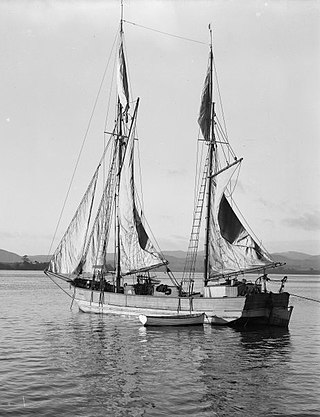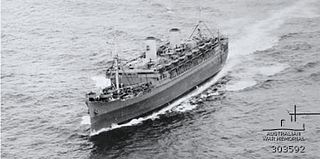USS Echo (IX-95), an unclassified miscellaneous vessel, was the only ship of the United States Navy to be named for the nymph Echo. A sailing scow, she was used as a supply ship in the South Pacific from 1942 to 1944.
USS Echo (IX-95), an unclassified miscellaneous vessel, was the only ship of the United States Navy to be named for the nymph Echo. A sailing scow, she was used as a supply ship in the South Pacific from 1942 to 1944.
A twin-masted scow (flat-bottomed schooner) of New Zealand registry, Echo was built in New Zealand in 1905 by William Brown, of kauri timber. She was originally topsail rigged. Twin diesel engines were installed in 1920.
She was transferred to the US Navy under reverse Lend-Lease from New Zealand and commissioned on 4 November 1942. [1] [2]
Sailing from Auckland on 11 November 1942, Echo delivered cargo at Noumea en route to Efate in the New Hebrides. Based on this island at Port Vila, she served as a supply ship for the United States Army in the New Hebrides and adjoining island groups as well as placing and supporting Coastwatchers. [1] [2] On 14 February 1944, just prior to her departure for New Zealand, the Army awarded her crew a commendation. She arrived at Wellington on 12 March 1944, was decommissioned three days later, and returned to the New Zealand Government. [1]
In 1942–44 she was used by US forces in the Pacific, and her story was the basis for the 1960 film with Jack Lemmon, The Wackiest Ship in the Army and the 1965 TV series of the same name. The storyline involved a secret mission with an Australian Coastwatcher, played by Chips Rafferty. [2]
She was in use carrying cargo from Marlborough to Wellington until 1965, and hence was not available for the film. She was then used from 1972 as clubrooms by the Marlborough Cruising Club, but she deteriorated, and was nearly broken up in 1990. She was preserved, but in poor condition, at Picton, New Zealand as the Echo Gallery, a scow museum and bar. After the bar closed and the ship deteroriated more, Port Marlborough bought the ship from its private owners, and she was broken up in April 2015. [3]

A scow is a smaller type of barge. Some scows are rigged as sailing scows. In the 19th and early 20th centuries, scows carried cargo in coastal waters and inland waterways, having an advantage for navigating shallow water or small harbours. Scows were in common use in the American Great Lakes and other parts of the U.S., Canada, southern England, and New Zealand. In modern times their main purpose is for recreation and racing.

USS Arided (AK-73), a Crater-class cargo ship, is the only ship of the US Navy to have this name. She was named after Arided, the other name of Deneb, the alpha star of constellation Cygnus.

USS Kitty Hawk (APV-1/AKV-1), formerly SS Seatrain New York, was a cargo ship that was converted into an aircraft transport during World War II.

USS Neville (AP-16/APA-9) was a Heywood-class attack transport in service with the United States Navy from 1918 to 1919 and from 1940 to 1946. She was scrapped in 1957.

USS Lyra (AK-101) was a Crater-class cargo ship in the service of the US Navy in World War II. It was the only ship of the Navy to have borne this name. It is named after the constellation Lyra.

USS Crater (AK-70) was the lead ship of her class of converted liberty ship cargo ships in the service of the US Navy in World War II. She was first named after John James Audubon, an American ornithologist, naturalist, and painter. She was renamed and commissioned after the constellation Crater, she was the only ship of the Navy to bear this name.

USS Cetus (AK-77) was a Crater-class cargo ship in the service of the US Navy in World War II. Named after the equatorial constellation Cetus, it was the only ship of the Navy to bear this name.

USS Gansevoort (DD-608) was a Benson-class destroyer in the United States Navy during World War II. She was named for Commodore Guert Gansevoort.

SS Mariposa was a luxury ocean liner launched in 1931, one of four ships in the Matson Lines "White Fleet", which included SS Monterey, SS Malolo, and SS Lurline. She was later renamed SS Homeric.

USS Libra (AK-53/AKA-12/LKA-12) was an Arcturus-class attack cargo ship named after the constellation Libra. She served as a commissioned ship for 11 years.

USS Birgit (AKA-24) was an Artemis-class attack cargo ship named after the minor planet 960 Birgit, which in turn was named after a daughter of Swedish astronomer Bror Ansgar Asplind. USS Birgit served as a commissioned ship for 16 months.

USS Wharton (AP-7) was a troop transport in the service of the United States Navy during World War II. The ship was originally an Emergency Fleet Corporation Design 1029 type built for the United States Shipping Board. The ship was laid down as Manmasco but renamed and launched as Sea Girt then completed September 1921 as Southern Cross. The ship was first allocated by the United States Shipping Board to the Munson Steamship Line until purchased by the line in 1925. Munson operated the Southern Cross in the South American trade from 1921 until 1938 when the ship was sold at a Marshall's sale and taken over by the United States Maritime Commission which paid the full mortgage claim.
USS Cygnus (AF-23) was a Cygnus-class cargo ship acquired by the U.S. Navy for service in World War II, named after the constellation Cygnus. She was responsible for delivering necessary goods and equipment to ships and stations in the war zone.

The Wackiest Ship in the Army is an American 1960 Eastmancolor CinemaScope comedy-drama war film directed by Richard Murphy and starring Jack Lemmon, Ricky Nelson, and Chips Rafferty. It was filmed at Pearl Harbor and Kauai.

USS Kailua (IX-71) was originally CS Dickenson, a civilian supply and personnel transport cable-repair ship of the Commercial Pacific Cable Company that was based in Honolulu serving the island cable stations at Midway and Fanning Island.

USS Briareus was originally the cargo ship SS Hawaiian Planter laid down as a Maritime Commission type C3 Mod. at Newport News, Virginia, by the Newport News Shipbuilding & Dry Dock Company for the Matson Line and delivered 15 May 1941. After a brief pre-war commercial service and allocation to the Army for transport the ship was purchased by the United States Navy in February 1943 and converted to a repair ship.

American Legion was built for the United States Shipping Board (USSB), one of the planned World War I troop transports converted before construction into passenger and cargo vessels, the Emergency Fleet Corporation Design 1029 ships. The ship was laid down as Koda and perhaps assigned the name Badger State at one point, but renamed American Legion before launch and one of only a few of the design not taking a state nickname. Originally operated by the USSB's agents and the Munson Steamship Line the ship saw commercial service until laid up 13 March 1939.

USS William Ward Burrows was a transport ship that saw service with the United States Navy in World War II. The ship was the former Grace Steamship Company liner MV Santa Rita by Burmeister & Wain and launched in 1929 at Copenhagen, Denmark.

USS Majaba (AG-43/IX-102) was the Design 1049 cargo ship Meriden built in 1919 by the Albina Engine & Machine Works, Portland, Oregon. All the ships were requisitioned by the United States Shipping Board (USSB) for World War I service. The ship was bought by the E. K. Wood Lumber Co., of San Francisco, California in 1923 and renamed El Capitan. The ship was chartered by the U.S. Navy through the War Shipping Administration (WSA) in April 1942 and commissioned as Majaba.

SS Mauna Loa was a steam-powered cargo ship of the Matson Navigation Company that was sunk in the bombing of Darwin in February 1942. She was christened SS West Conob in 1919 and renamed SS Golden Eagle in 1928. At the time of her completion in 1919, the ship was inspected by the United States Navy for possible use as USS West Conob (ID-4033) but was neither taken into the Navy nor commissioned.
This article incorporates text from the public domain Dictionary of American Naval Fighting Ships .